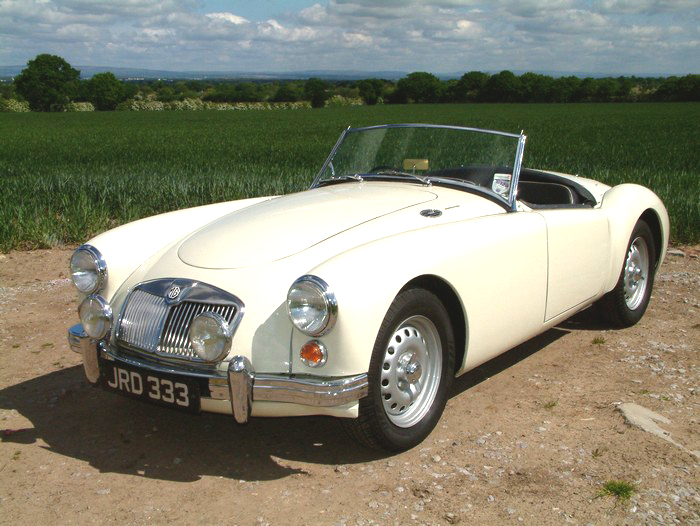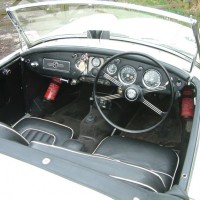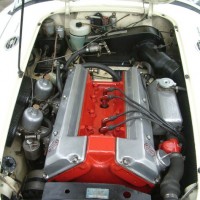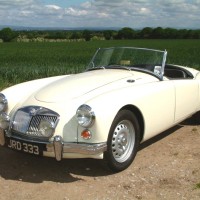Conceived as a replacement for the traditional T-Series MGs and introduced in 1955, the MGA combined a rigid chassis with the Austin-designed, 1,489-cc B-Series engine that had first appeared in the ZA Magnette. Running gear was based on the TF, with independent coil-sprung wishbone front suspension and a live rear axle. Clad in a curvaceous aerodynamic body and capable of topping 95 mph, the MGA proved an instant hit, selling 13,000 cars in its first full year of production.
Immensely popular though it was, the MGA faced stiff competition from the larger-engined Triumph TR3 and Austin-Healey 100-6. Coaxing more power from the standard engine was becoming increasingly difficult, so development concentrated on a twin-overhead-camshaft cylinder head for the B-Series block. Conceived at Cowley by BMC engineer Gerald Palmer and introduced in 1958, the new engine did not disappoint, producing an impressive 108 horsepower at 6,700 rpm.
Considerably faster than the stock MGA, the Twin Cam could comfortably exceed 110 mph, and to cope with the increased performance, Dunlop disc brakes were fitted all around, and Dunlop center-lock wheels were adopted. A high price discouraged sales, however, and the model was dropped after just two years. Production totaled 2,111 cars, a mere 360 of which were sold in Great Britain, and today the Twin Cam is one of the most sought-after of post-war MG sports cars.
This car, chassis number YD11580, left the factory on March 16, 1959, for delivery to Leeds dealers Isaac Swires & Sons Ltd. Just over one month later, the car was competing in the first of the two Tulip Rallies in which it would take part in the hands of private owner Harry Mainz.
Although not a true Works entry, it ran as Number 30, following the Works cars, Number 28 driven by John Gott and Number 29 driven by John Sprinzel. This lineup is illustrated in a period photograph contained in the history file together with a letter from MG Competitions Department staff member Bill Price. The file also contains the original Tulip Rally timing and results books from 1959 and 1960 — plus the car’s original buff logbook that documents the registration number change from XWU285 to JRD333.
Approximately 28 years ago, the car was purchased by Paul Channon, a well-known motor-racing personality and owner of the BMC agency in Bournemouth, who rebuilt it to use in historic rallying. He rebuilt the MGA to a high competition standard, with special camshafts and 9.9:1-compression pistons — plus three-point harnesses, Marchal spotlights, Halda Tripmaster, and so forth.
From 1986 to 2005, Channon competed in 46 rallies with much success, achieving 25 class wins, eight 2nd in class and four 3rd in class, including nine top-three overall finishes (and only two DNFs).
The current vendor purchased the MG at Bonhams’ Goodwood Festival of Speed sale in 2010 (Lot 335), and it has been used sparingly since. Competition-prepared yet easily tractable enough for everyday road use, this very special MGA is in exceptional condition and ready to compete in any historic rally. It comes complete with FIA/HSCC/VSCC papers and RAC logbook, and is expected to possess a fresh MoT by time of sale. The sale also included a substantial amount of documentation on the car, including period photographs and related literature, as well as spare and replacement parts.
SCM Analysis
Detailing
| Vehicle: | 1959 MG A Twin-Cam roadster |
| Number Produced: | 2,111 |
| Original List Price: | $3,345 |
| Tune Up Cost: | $500 |
| Chassis Number Location: | Stamped tag screwed to shelf at rear of engine compartment |
| Engine Number Location: | Embossed plate screwed to ledge on engine next to spark plugs |
| Club Info: | North American MGA Register or MG Vintage Racers |
| Website: | http://www.namgar.com |
This car, Lot 105, sold for $60,614, including buyer’s premium, at Bonhams’ Goodwood Revival sale on September 15, 2012.
The MGA Twin Cam — or “Twink” as it is affectionately known among Octagon enthusiasts — is that most interesting of all collectibles: rare and desirable enough to be accepted in virtually all invitation-only classic-car events, but still less expensive than even run-of-the-mill restored Austin-Healeys.
Witness this example, in excellent and usable condition but with period competition provenance, selling for the price of a Ferrari engine rebuild.
Cheap, quick and fun
One might ask why MGAs don’t get the respect they deserve, but members of the various and very active organizations that support the marque really don’t mind. Living in the shadow of Jaguars and Austin-Healeys, MGAs have continued to be affordable — not to mention reliable, lovable and fun.
Before taking up the arcane nature of the twin-cam engine, let’s talk about the features shared in common with the other models of the MGA. Almost exactly the same size as the “Big” Healey, the MGA nevertheless manages to look smaller, probably because of the longer bonnet and tail sections that compress the cockpit to a snug-but-comfortable fit for two friendly individuals.
The design also has minimal chrome — not only are there no door handles, but even the boot releases from inside, so there’s no external handle on that, either. Nevertheless, with adequate trunk space for some soft-sided luggage — supplemented with a factory-style luggage rack if desired — two people can tour in reasonable comfort on a 1,000-mile event.
The sturdy chassis and well-sorted suspension in common across the whole MGA lineup are also a positive factor. The car is solid on the road, and it is very predictable in its handling, making it a great choice for competition as well as street use.
The yin and yang of the twin cam
But there are definite minuses as well as pluses to the twin-cam engine. The obvious plus is that when in good shape, the extra horsepower and pickup makes the car confident in the give-and-take of modern traffic. A realistic top speed in excess of 100 mph and 0–60 mph acceleration under 10 seconds are comparable on the highway with any modern compact economy model. In addition, the four-wheel disc brakes — very innovative for the time on any sports car — gave the car exceptional stopping power.
A second advantage is that the twin cam is not rocket-science technology. In common with other British designs, pretty much all the work that needs to be done can be carried out with the tools in the roll in the boot and a small bag of standard replacement parts. No need to trailer the car to the shop of someone named Guido, as Nigel should be able to sort out almost anything in the parking lot while you’re having lunch.
So why were the twin cams phased out after only two years and 2,111 cars? Unfortunately, they had a singular problem that BMC wasn’t able to solve at the time. When driven at the high revs they enticed their drivers into, they had a bad habit of overheating and burning pistons, which led to blown engines and expensive rebuilds. Even the expedient of fitting out special buses and sending instructors on the road to teach British car-dealer mechanics how to tune the cars didn’t avert a huge warranty bill.
There were a variety of explanations for the problem at the time, including poorly set timing and compression too high for available fuel. Rather than solving the problem, BMC simply phased out the twin cams, moving to an enlarged (1,622-cc) version of the pushrod engine.
Today, the handful of smart twin-cam drivers, such as Bill Spohn, in the MG Vintage Racing group, believe they have solved the problem. Spohn notes that rather than being a timing or compression issue, as was thought at the time, the problem was with the carburetor mounts.
Fastened tightly to the intake manifolds, the carbs — which in production weren’t nearly as well balanced as they should have been — vibrated with the engine. As the engine approached maximum power, a harmonic vibration would cause the float on the rear carburetor to bind on its spindle, leaning out the mixture and causing the engine to overheat in short order, often resulting in a hole in the number 3 or number 4 piston. The simple expedients of balancing the engine and flexibly mounting the carburetors with rubber O-Rings in the gaskets have made the few remaining engines almost bulletproof.
An excellent buy
Taking all of the factors into account, the example that sold at Bonhams was extremely well bought, and any good Twink that appears at auction is a worthwhile purchase indeed. Comfortable on tour, competitive in vintage racing, and above all, probably the most desirable for the price at any invitation-only event, any complete MGA Twin Cam is a good buy today. ?
(Introductory description courtesy of Bonhams.)



